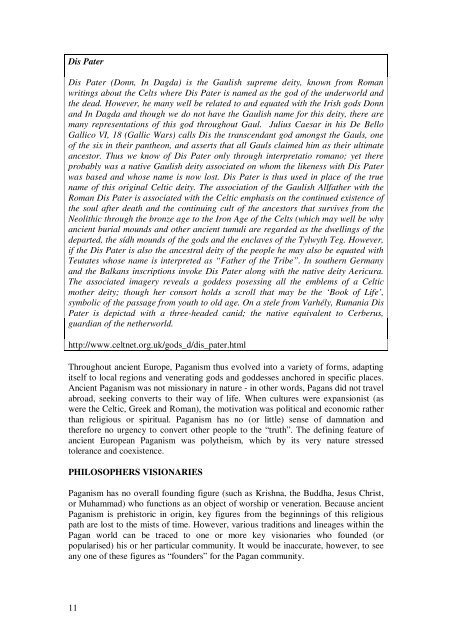Paganism an overview introduction - South African Pagan Council
Paganism an overview introduction - South African Pagan Council
Paganism an overview introduction - South African Pagan Council
You also want an ePaper? Increase the reach of your titles
YUMPU automatically turns print PDFs into web optimized ePapers that Google loves.
Dis Pater<br />
Dis Pater (Donn, In Dagda) is the Gaulish supreme deity, known from Rom<strong>an</strong><br />
writings about the Celts where Dis Pater is named as the god of the underworld <strong>an</strong>d<br />
the dead. However, he m<strong>an</strong>y well be related to <strong>an</strong>d equated with the Irish gods Donn<br />
<strong>an</strong>d In Dagda <strong>an</strong>d though we do not have the Gaulish name for this deity, there are<br />
m<strong>an</strong>y representations of this god throughout Gaul. Julius Caesar in his De Bello<br />
Gallico VI, 18 (Gallic Wars) calls Dis the tr<strong>an</strong>scend<strong>an</strong>t god amongst the Gauls, one<br />
of the six in their p<strong>an</strong>theon, <strong>an</strong>d asserts that all Gauls claimed him as their ultimate<br />
<strong>an</strong>cestor. Thus we know of Dis Pater only through interpretatio rom<strong>an</strong>o; yet there<br />
probably was a native Gaulish deity associated on whom the likeness with Dis Pater<br />
was based <strong>an</strong>d whose name is now lost. Dis Pater is thus used in place of the true<br />
name of this original Celtic deity. The association of the Gaulish Allfather with the<br />
Rom<strong>an</strong> Dis Pater is associated with the Celtic emphasis on the continued existence of<br />
the soul after death <strong>an</strong>d the continuing cult of the <strong>an</strong>cestors that survives from the<br />
Neolithic through the bronze age to the Iron Age of the Celts (which may well be why<br />
<strong>an</strong>cient burial mounds <strong>an</strong>d other <strong>an</strong>cient tumuli are regarded as the dwellings of the<br />
departed, the sídh mounds of the gods <strong>an</strong>d the enclaves of the Tylwyth Teg. However,<br />
if the Dis Pater is also the <strong>an</strong>cestral deity of the people he may also be equated with<br />
Teutates whose name is interpreted as “Father of the Tribe”. In southern Germ<strong>an</strong>y<br />
<strong>an</strong>d the Balk<strong>an</strong>s inscriptions invoke Dis Pater along with the native deity Aericura.<br />
The associated imagery reveals a goddess posessing all the emblems of a Celtic<br />
mother deity; though her consort holds a scroll that may be the ‘Book of Life’,<br />
symbolic of the passage from youth to old age. On a stele from Varhély, Rum<strong>an</strong>ia Dis<br />
Pater is depictad with a three-headed c<strong>an</strong>id; the native equivalent to Cerberus,<br />
guardi<strong>an</strong> of the netherworld.<br />
http://www.celtnet.org.uk/gods_d/dis_pater.html<br />
Throughout <strong>an</strong>cient Europe, <strong>Pag<strong>an</strong>ism</strong> thus evolved into a variety of forms, adapting<br />
itself to local regions <strong>an</strong>d venerating gods <strong>an</strong>d goddesses <strong>an</strong>chored in specific places.<br />
Ancient <strong>Pag<strong>an</strong>ism</strong> was not missionary in nature - in other words, Pag<strong>an</strong>s did not travel<br />
abroad, seeking converts to their way of life. When cultures were exp<strong>an</strong>sionist (as<br />
were the Celtic, Greek <strong>an</strong>d Rom<strong>an</strong>), the motivation was political <strong>an</strong>d economic rather<br />
th<strong>an</strong> religious or spiritual. <strong>Pag<strong>an</strong>ism</strong> has no (or little) sense of damnation <strong>an</strong>d<br />
therefore no urgency to convert other people to the “truth”. The defining feature of<br />
<strong>an</strong>cient Europe<strong>an</strong> <strong>Pag<strong>an</strong>ism</strong> was polytheism, which by its very nature stressed<br />
toler<strong>an</strong>ce <strong>an</strong>d coexistence.<br />
PHILOSOPHERS VISIONARIES<br />
<strong>Pag<strong>an</strong>ism</strong> has no overall founding figure (such as Krishna, the Buddha, Jesus Christ,<br />
or Muhammad) who functions as <strong>an</strong> object of worship or veneration. Because <strong>an</strong>cient<br />
<strong>Pag<strong>an</strong>ism</strong> is prehistoric in origin, key figures from the beginnings of this religious<br />
path are lost to the mists of time. However, various traditions <strong>an</strong>d lineages within the<br />
Pag<strong>an</strong> world c<strong>an</strong> be traced to one or more key visionaries who founded (or<br />
popularised) his or her particular community. It would be inaccurate, however, to see<br />
<strong>an</strong>y one of these figures as “founders” for the Pag<strong>an</strong> community.<br />
11


